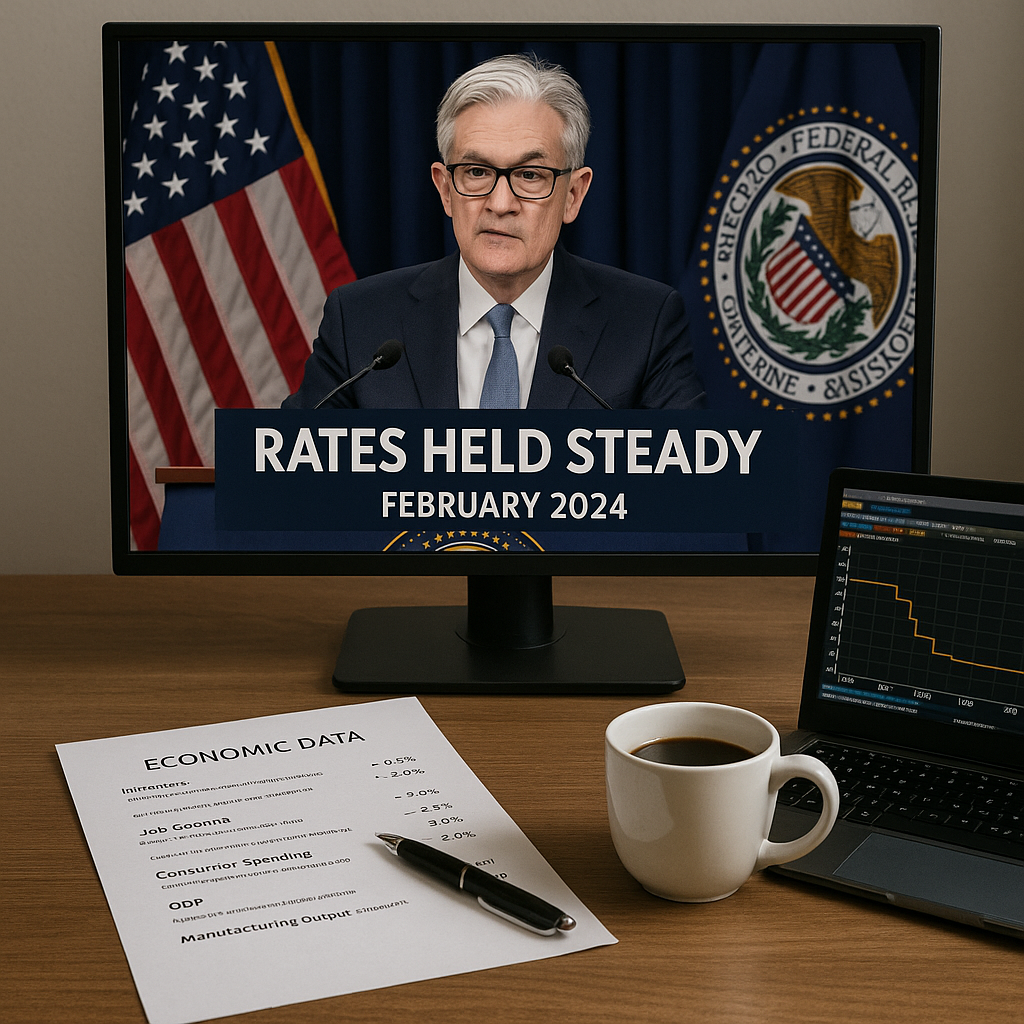Fed Holds Rates Steady Amid Mixed Economic Data
On February 14, 2024, the Federal Reserve announced it would keep its benchmark interest rate unchanged at the current target range of 5.25% to 5.50%, marking the fourth consecutive meeting without a hike. The decision reflects the Fed’s ongoing balancing act between moderating inflation and slowing economic momentum — with data still sending conflicting signals.
The policy statement and subsequent comments from Fed Chair Jerome Powell indicate a shift from aggressive tightening to a more data-dependent stance. However, rate cuts remain off the table for now.
What Prompted the Fed’s Decision?
Recent U.S. economic data has painted a mixed picture:
Inflation Trends
-
Headline CPI for January rose 3.1% year-over-year, slightly above expectations.
-
Core inflation (excluding food and energy) remains sticky at 3.7%, down from mid-2023 highs but well above the Fed’s 2% target.
-
PCE data, the Fed’s preferred inflation measure, is showing a gradual deceleration but with uneven progress across categories.
Labor Market
-
The January jobs report showed 353,000 jobs added, surprising to the upside.
-
Unemployment remains low at 3.7%, suggesting labor market strength.
-
However, wage growth has moderated, and job openings have declined from 2022 levels.
Consumer Behavior
-
Retail sales slipped slightly in January, hinting at cautious consumer sentiment.
-
Credit card delinquencies have edged higher, and household savings rates remain below pre-pandemic norms.
Altogether, the data suggests an economy that is resilient but cooling, prompting the Fed to hold rates steady while maintaining a cautious tone.
Fed Statement Highlights
The Federal Open Market Committee (FOMC) statement maintained key language around monitoring incoming data and signaled that:
-
No rate cuts are currently scheduled, though the door remains open for adjustment.
-
The Fed “does not expect it will be appropriate to reduce the target range until it has gained greater confidence that inflation is moving sustainably toward 2 percent.”
-
Balance sheet runoff will continue at the current pace, maintaining quantitative tightening.
Chair Jerome Powell reinforced this message in the press conference:
“We are encouraged by recent inflation trends, but we are not yet at the point where we can begin easing. Patience is still required.”
Market Reaction
Financial markets had largely priced in a hold, but expectations around the timing of future rate cuts are beginning to shift.
Equities
-
The S&P 500 held steady, with investors interpreting the Fed’s tone as neutral.
-
Tech stocks pulled back slightly, reflecting uncertainty around rates and earnings season outcomes.
-
Banking stocks saw mild gains, supported by the prospect of stable yields.
Bonds
-
The 10-year Treasury yield moved marginally higher to 4.23%.
-
Short-term yields were more volatile as traders recalibrated rate cut expectations.
-
The yield curve remains inverted, but with narrowing differentials.
Crypto and Alternative Assets
-
Bitcoin held above $49,000, buoyed by broader risk sentiment and post-ETF inflows.
-
Gold remained stable near $2,020 per ounce, reflecting subdued inflation fears.
What Does This Mean for the Rest of 2024?
The Fed’s decision to pause, but not pivot, leaves investors and analysts debating what comes next.
Scenarios to Watch:
1. Inflation Falls Further
-
Rate cuts could begin by mid-2024, potentially starting in June or July.
-
Markets may rally as borrowing costs decline, especially in housing and tech.
2. Inflation Plateaus
-
The Fed holds rates steady for the remainder of the year.
-
Growth slows, but a soft landing remains possible.
3. Inflation Reaccelerates
-
A surprise spike in energy prices or wages could prompt a renewed tightening cycle.
-
Risk assets could face significant headwinds.
Current market pricing (via fed funds futures) suggests two or three rate cuts by year-end, but the Fed has emphasized that it needs more clarity before changing direction.
Sector Implications
Housing
-
Mortgage rates remain elevated around 6.8%, limiting affordability and keeping pressure on homebuilders.
-
A cut later this year could stimulate activity, but not significantly in the near term.
Credit Markets
-
Corporate bond issuance remains robust, though high-yield spreads are widening slightly.
-
Rising consumer delinquencies may lead to tightening credit conditions from banks.
Commodities
-
Oil prices remain range-bound between $75 and $80 per barrel.
-
Agricultural and industrial commodities are holding steady, with modest upside linked to global demand.
Final Thoughts: Patience as Policy
The February 2024 Fed meeting underscores a broader shift: from active intervention to cautious observation. After one of the most aggressive tightening cycles in decades, the Fed is now in wait-and-see mode, watching for confirmation that inflation is indeed on a sustainable path downward.
For investors, this means volatility may return, particularly around key economic releases like CPI, PCE, and job reports. But it also signals that the Fed is no longer a source of weekly surprises — at least for now.
Markets are preparing for a pivot, but the Fed is not quite ready to move. Until then, steady hands and close data monitoring remain the name of the game.
